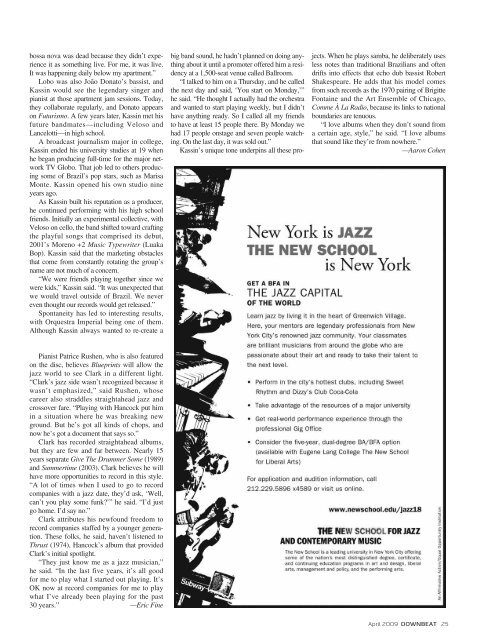Create successful ePaper yourself
Turn your PDF publications into a flip-book with our unique Google optimized e-Paper software.
ossa nova was dead because they didn’t experience<br />
it as something live. For me, it was live.<br />
It was happening daily below my apartment.”<br />
Lobo was also João Donato’s bassist, and<br />
Kassin would see the legendary singer and<br />
pianist at those apartment jam sessions. Today,<br />
they collaborate regularly, and Donato appears<br />
on Futurismo. A few years later, Kassin met his<br />
future bandmates—including Veloso and<br />
Lancelotti—in high school.<br />
A broadcast journalism major in college,<br />
Kassin ended his university studies at 19 when<br />
he began producing full-time for the major network<br />
TV Globo. That job led to others producing<br />
some of Brazil’s pop stars, such as Marisa<br />
Monte. Kassin opened his own studio nine<br />
years ago.<br />
As Kassin built his reputation as a producer,<br />
he continued performing with his high school<br />
friends. Initially an experimental collective, with<br />
Veloso on cello, the band shifted toward crafting<br />
the playful songs that comprised its debut,<br />
2001’s Moreno +2 Music Typewriter (Luaka<br />
Bop). Kassin said that the marketing obstacles<br />
that come from constantly rotating the group’s<br />
name are not much of a concern.<br />
“We were friends playing together since we<br />
were kids,” Kassin said. “It was unexpected that<br />
we would travel outside of Brazil. We never<br />
even thought our records would get released.”<br />
Spontaneity has led to interesting results,<br />
with Orquestra Imperial being one of them.<br />
Although Kassin always wanted to re-create a<br />
Pianist Patrice Rushen, who is also featured<br />
on the disc, believes Blueprints will allow the<br />
jazz world to see Clark in a different light.<br />
“Clark’s jazz side wasn’t recognized because it<br />
wasn’t emphasized,” said Rushen, whose<br />
career also straddles straightahead jazz and<br />
crossover fare. “Playing with Hancock put him<br />
in a situation where he was breaking new<br />
ground. But he’s got all kinds of chops, and<br />
now he’s got a document that says so.”<br />
Clark has recorded straightahead albums,<br />
but they are few and far between. Nearly 15<br />
years separate Give The Drummer Some (1989)<br />
and Summertime (2003). Clark believes he will<br />
have more opportunities to record in this style.<br />
“A lot of times when I used to go to record<br />
companies with a jazz date, they’d ask, ‘Well,<br />
can’t you play some funk?’” he said. “I’d just<br />
go home. I’d say no.”<br />
Clark attributes his newfound freedom to<br />
record companies staffed by a younger generation.<br />
These folks, he said, haven’t listened to<br />
Thrust (1974), Hancock’s album that provided<br />
Clark’s initial spotlight.<br />
“They just know me as a jazz musician,”<br />
he said. “In the last five years, it’s all good<br />
for me to play what I started out playing. It’s<br />
OK now at record companies for me to play<br />
what I’ve already been playing for the past<br />
30 years.” —Eric Fine<br />
big band sound, he hadn’t planned on doing anything<br />
about it until a promoter offered him a residency<br />
at a 1,500-seat venue called Ballroom.<br />
“I talked to him on a Thursday, and he called<br />
the next day and said, ‘You start on Monday,’”<br />
he said. “He thought I actually had the orchestra<br />
and wanted to start playing weekly, but I didn’t<br />
have anything ready. So I called all my friends<br />
to have at least 15 people there. By Monday we<br />
had 17 people onstage and seven people watching.<br />
On the last day, it was sold out.”<br />
Kassin’s unique tone underpins all these pro-<br />
jects. When he plays samba, he deliberately uses<br />
less notes than traditional Brazilians and often<br />
drifts into effects that echo dub bassist Robert<br />
Shakespeare. He adds that his model comes<br />
from such records as the 1970 pairing of Brigitte<br />
Fontaine and the Art Ensemble of Chicago,<br />
Comme À La Radio, because its links to national<br />
boundaries are tenuous.<br />
“I love albums when they don’t sound from<br />
a certain age, style,” he said. “I love albums<br />
that sound like they’re from nowhere.”<br />
—Aaron Cohen<br />
April 2009 DOWNBEAT 25

















